

Tim O’Reilly: Silicon Valley is massively underestimating the impact of IoT (interview) Smart forks.
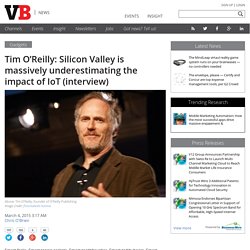
Smart tennis rackets. Smart toothbrushes. Smart teddy bears. Smart fitness bands. Will the Internet of things turn into a Tower of Babel? The emergence of smart devices means we can receive the same notification on everything in the house, from our phone to our TV to our air conditioner.

The technology promises an unprecedented age of connectedness and efficiency — provided that the devices can speak to each other. Internet of Everything. Will the Internet of Things make us slaves to our lesser natures? By James Robinson On February 17, 2014.
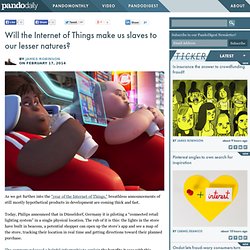
Does the World Really Need Smart Toothbrushes? Today, at the opening of the World Mobile Congress in Barcelona, Oral-B unveiled what’s being called the “world’s first smart toothbursh” (although that “first” bit is up for debate).

PhysOrg reports: “It is a world first,” said Michael Cohen-Dumani, head of Procter & Gamble’s Oral-B brand, which plans to sell the product in Europe, the United States and Asia from June.Sold for 219 euros ($300), the brush relays your toothbrushing activity to an application on the smartphone, recording whether you respect the two-minute rule and whether you brush hard, but not too hard.If the results are satisfactory, a message appears on your smartphone: “Congratulations: your teeth are shining.” The Internet of Things is not a Trend. Internet of Things The Internet of Things is not a Trend.
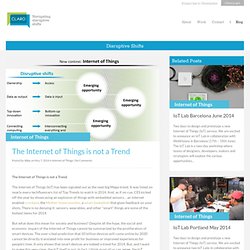
The Internet of Things (IoT) has been signaled out as the next big Mega-trend. It was listed on nearly every techfluencers list of Top Trends to watch in 2014. In praise of boring objects — Product Club. It’s an exciting time to be involved in the Internet of Things.
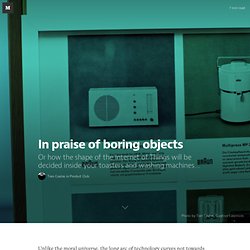
It’s been almost thirty years since people started hypothesizing about a world of ubiquitous and pervasive computation, and twenty since the first toasters and coffee pots were connected to the internet. Over that time we’ve seen endless playful experiments and explorations of how objects might connect to each other and to us in thrilling new combinations of object + computation + network. But almost none of this work has reached the general public. Only now is that starting to change, and fundamentally that’s because evolving technologies and interaction patterns have reached a sufficient level of maturity to finally let the potential unfold. Why Tech’s Best Minds Are Very Worried About the Internet of Things. Illustration: Pat Kinsella The Internet of Things is coming.
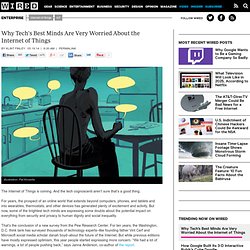
And the tech cognoscenti aren’t sure that’s a good thing. For years, the prospect of an online world that extends beyond computers, phones, and tablets and into wearables, thermostats, and other devices has generated plenty of excitement and activity. But now, some of the brightest tech minds are expressing some doubts about the potential impact on everything from security and privacy to human dignity and social inequality. The philosophy of IoT: Will it help or hurt? The Internet of Things helps insurance firms reward, punish. Solid The more the Internet of Things knows about you, the more that insurance companies are able to slurp that data and incentivize you to walk the straight and narrow.

"You know the way that advertising turned out to be the native business model for the internet? I think that insurance is going to be the native business model for the Internet of Things," said Tim O'Reilly, founder and CEO of O'Reilly Media at his company's Solid conference in San Francisco on Thursday. His partner in the presentation, IBM's Rod Smith, who holds the wonderfully named position of VP of Emerging Internet Technology, was succinct in his agreement.
"I think it is," he said. Smith should know. "When you use the device and incorporate other healthy habits, you'll earn a variety of rewards and discounts," the Active Track program promises. Fitbit, by the way, runs its personal data–gathering system on IBM's SoftLayer public cloud, which Big Blue acquired last July.
The Real Reason Apple Wants You to Talk to Your House. Apple's foray into "the Internet of Things" is less about the things, and more about the Internet.

Ari N/Shutterstock “In a few decades’ time,” the computer scientist Karl Steinbuch wrote, “computers will be interwoven into almost every industrial product.” That was in 1966. Since then, futurists and realists alike have talked about a potential world whose physical objects, from cars to toasters, are digitally interconnected. The telco quandary, do we need a new internet for the internet of things? Do we need a new internet for the internet of things?

One of the certainties in mobile networks is that data demands will continue to grow exponentially, how operators manage this will have major consequences for the Internet of Things. As part of their Networked Society survey, cellular equipment vendor Ericsson forecasts that by 2019 50% of mobile traffic will be video. Competing data demands For the carriers, the problem is high value corporate M2M traffic has to compete with those videos to get their low volume but business critical data transmitted across crowded networks.
Resolving that quandary between consumer and business data traffic is going to be a priority for telcos as both consumer demand and mobile business applications grow and test the limits of network capabilities. A new internet for the IoT. The Nightmare on Connected Home Street. Illustration: Getty I wake up at four to some old-timey dubstep spewing from my pillows. The lights are flashing. My alarm clock is blasting Skrillex or Deadmau5 or something, I don’t know. I never listened to dubstep, and in fact the entire genre is on my banned list. You see, my house has a virus again. Technically it’s malware. I don’t sleep well anyway, and already had my Dropcam Total Home Immersion account hacked, so I’m basically embarrassment-proof.
UX Grid of IOT. Deconstructing IoT Part 2In a previous post, I had a modest goal of introducing a simple functional vocabulary for smart devices. Too many journalists were discussing science fiction scenarios about swarms of devices without realizing that there were much simpler, yet very valuable alternatives. This post moves into user experience, proposing a simple grid of types.
There are of course, many ways to break things down, this is just one that I’m finding useful. I hope this prompts a discussion of other approaches. If you have any suggestions, please let me know. Device vs StyleThis UX Grid is a classic 2×2 matrix of device type vs interaction type. Direct DeviceThis is the primary product concept we use today, products like the Nest, or Sonos, or the iGrill, or the Withings Scale (you get the idea…) are devices you interact with directly using a dedicated application on your phone. But this Direct Device model is really only an extension of what we’ve been doing for 30 years. Deconstructing the Internet of things. Smart Toaster When talking about the Internet of things (or IoT), I frequently bring up a Smart Toaster as it is such a lightning rod. People just love to make fun of it. My favorite was the tweet, “I don’t think my smart toaster needs apps” which off course was retweeted into the stratosphere. When I read things like this, I just shake my head.
You can’t evaluate tomorrow’s concepts by yesterday’s tasks! Of course a smart toaster doesn’t need apps. Wearables have a dirty little secret: 50% of users lose interest. There's a little-known fact about wearables that manufacturers don't advertise to consumers: Most people lose interest within a few months. Tech wearables, particularly those for health and fitness, fail to keep the interest of users for more than a few months.
A survey of 6,223 US adults revealed that one in ten consumers age 18 and over owns a modern activity tracker such as Jawbone, Fitbit, Nike+ Fuelband or Misfit Wearables. Yet, more than half of the survey’s respondents said that they no longer use their activity tracker, and a third of those stopped using the device within six months of receiving it. The survey was conducted by Endeavour Partners and the results were published last month in a white paper, “Inside Wearables: How the Science of Human Behavior Change Offers the Secret to Long-Term Engagement.” The goal of the paper is to help the manufacturers of wearables learn how to make their products more enticing, and therefore, more successful. The Problem With Wearable Tech Today.
Why is wearable technology so damn ugly? Wearable technology is moving in the wrong direction — Tech Talk. The next revolution of how we interact with technology is almost here… or so they keep telling me. Technology is supposed to help us with our lives, enrich it, not take it over. One could argue that the smartphone has already taken over humanity, just look at the bus stops, or the coffee shops, or university lectures.
They are everywhere, and no one is putting them down. They are disrupting workflows, they are causing car accidents, and effectively modifying laws because of it. But people forget something… we choose to take out these phones from pockets and drawers. But we had a choice, and current wearable technology concepts are about to take that away. The general concepts behind current wearable technology are wrong. Of Stupid Smartwatches And Gimmicks: Wearable Tech's Design Problem. The Internet of Things Will Ruin Birthdays — The Message. Some time in the near future: Trust Is Not An Algorithm: Design Observer. Illustration from By some accounts the world’s information is doubling every two years.
This impressive if unprovable fact has got many people wondering: what to do with it? Many big brands hope that the analysis of Big Data will give them a ‘360 degree view’ of customers: Who they’re interacting with, where they shop, how they think about a bank, hotel, or store. Banks and insurance companies are especially fired up by the prospect that Big Data will yield more accurate and profitable pricing models. Of Stupid Smartwatches And Gimmicks: Wearable Tech's Design Problem. The Problem With Wearable Technology, According To "Blade Runner" Designer Syd Mead. If anyone can call himself a "visual futurist" with a straight face, it's Syd Mead, the legendary concept artist behind Blade Runner, Tron, and Aliens. I could think of no one better qualified to critique the present and future of worn technologies for our special theme week on wearables, so I caught up with Mead via email, where he explained to me that "wearables" as a term are meaningless in their scope.
And the products on or coming to market today, by companies like Apple and Google, are little more than failed fashion attempts.